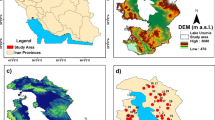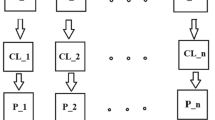Abstract
In machine learning, ensemble learning methods (ELM) consist of combining several machine learning algorithms to obtain better quality predictions compared to a single model. The basic idea of this theory is to learn a set of classifiers and allow them to vote. In this paper, to correctly apply the ELM for enhancing of an artificial neural network (ANN) performances, a strategy was devised which is to divide the data to be classified into two categories, ‘easy-to-classify’ category and ‘difficult-to-classify’ category using a main ANN. Hence, reliable ANN and unreliable ANN are created and applied for the classification of ‘easy-to-classify’ data and for the classification of ‘difficult-to-classify’ data, respectively. The AdaBoost algorithm and Bagging algorithm are implemented separately on the unreliable ANN. To increase performance, the AdaBoost results and Bagging results are merged. The developed scheme is applied to remote sensing images from Meteosat Second Generation (MSG). The final results show very interesting performances in the case of the fusion of the results from AdaBoost-ANN and the results from Bagging-ANN (Ada/Bag-ANN). Indeed, the POD, FAR, CSI and Bias pass from 87.2%, 17.4%, 80.8% and 1.3 (ANN) to 96.8%, 06.8%, 92.7% and 1.1 (Ada/Bag-ANN), respectively. The same trend was observed in the case of precipitation estimates. The estimates obtained from the developed model (Ada/Bag-ANN) largely surpass those obtained from the use of ANN without ELM. Compared to ECST (Enhanced Convective Stratiform Technique), EPSAT-SG (Second Generation Satellite Precipitation Estimation), TAMSAT (Tropical Applications of Meteorology using SATellite), and RFE-2.0 (Rain Fall Estimate) which showed correlation coefficients of 87%, 81%, 76% and 71%, respectively, the Ada/Bag-ANN method shows significantly better results with a correlation coefficient of 94%.









Similar content being viewed by others
References
Ackerman S A, Strabala K I, Menzel W P, Frey R A, Moeller C C and Gumley L E 1998 Discriminating clear sky from clouds with MODIS; J. Geophys. Res. Atmos. 103 32,141–32,157.
Adler R F and Negri A J 1998 A satellite infrared technique to estimate tropical convective and stratiform rainfall; J. Appl. Meteorol. 27 30–51.
Arkin P A 1979 The relationship between the fractional coverage of high cloud and rainfall accumulations during GATE over the Bscale array; Mon. Weather Rev. 107 1382–1387.
Baum B A and Platnick S 2006 Introduction to MODIS cloud products; In: Earth Science Satellite Remote Sensing: Science and Instruments (eds) Qu J J, Gao W, Kafatos M, Murphy R E and Salomonson V V, Springer, Berlin, Heidelberg, 78p.
Belmahdi F, Lazri M, Ouallouche F, Labadi K, Absi R and Ameur S 2023 Application of Dempster–Shafer theory for optimization of precipitation classification and estimation results from remote sensing data using machine learning; Remote Sens. Appl. Soc. Environ. 29 100906.
Bensafi N, Lazri M and Ameur S 2019 Novel WkNN-based technique to improve instanta-neous rainfall estimation over the north of Algeria using the multispectral MSG SEVIRI imagery; J. Atmos. Sol. Terr. Phys. 183 110–119, https://doi.org/10.1016/j.jastp.2018.12.004.
Berges J C, Jobard I, Chopin F and Roca R 2010 EPSAT-SG: A satellite method for precipitation estimation; its concepts and implementation for the AMMA experiment; Ann. Geophys. 28 289–308.
Breiman L 1996 Bagging predictors; Mach. Learn. 24 123–140.
Breiman L 1998 Arcing classifier (with discussion and a rejoinder by the author); Ann. Statist. 26(3) 801–849, https://doi.org/10.1214/aos/1024691079.
Breiman L 2000 Some infinity theory for predictor ensembles, Technical Report 579, Statistics Dept., UCB.
Du P, Bai X and Tan K et al. 2020 Advances of four machine learning methods for spatial data handling: A review; J. Geovis. Spat. Anal. 4 13, https://doi.org/10.1007/s41651-020-00048-5.
EUMETSAT 2004 Applications of meteosat second generation – conversion from counts to radiances and from radiances to brightness temperatures and reflectance; http://oiswww.eumetsat.org/WEBOPS/msg_interpretation/index.html.
Feidas H and Giannakos A 2011 Classifying convective and stratiform rain using multispectral infrared Meteosat second generation satellite data; Theor. Appl. Climatol. 108 613–630, https://doi.org/10.1007/s00704-011-0557-y.
Freund Y and Schapire R E 1995 A desicion-theoretic generalization of on-line learning and an application to boosting; In: Computational Learning Theory, EuroCOLT 1995. Lecture Notes in Computer Science (eds) Vitányi P, vol. 904, Springer, Berlin, Heidelberg, https://doi.org/10.1007/3-540-59119-2_166.
González S, Salvador G, Javier D S, Lior R and Francisco H 2020 A practical tutorial on bagging and boosting based ensembles for machine learning: Algorithms, software tools, performance study, practical perspectives and opportunities; Inf. Fusion 64 205–237.
Grimes D I F, Pardo E and Bonifacio R 1999 Optimal areal rainfall estimation using raingauges and satellite data; J. Hydrol. 222 93–108.
Hameg S, Lazri M and Ameur S 2016 Using naive Bayes classifier for classification of convective rainfall intensities based on spectral characteristics retrieved from SEVIRI; J. Earth Syst. Sci. 125 945–955, https://doi.org/10.1007/s12040-016-0717-7.
Hu X, Mei H and Zhang H et al. 2021 Performance evaluation of ensemble learning techniques for landslide susceptibility mapping at the Jinping County, Southwest China; Nat. Hazards 105 1663–1689, https://doi.org/10.1007/s11069-020-04371-4.
Jinchang R 2012 ANN vs. SVM: Which one performs better in classification of MCCs in mammogram imaging; Knowl. Based Syst. 26 144–153.
Kuhnlein M, Appelhans T, Thies B and Nauss T 2014 Improving the accuracy of rainfall rates from optical satellite sensors with machine learning – a Random Forests-based approach applied to MSG SEVIRI; Remote Sens. Environ. 141 129–143.
Kuncheva L and Whitaker C 2003 Measures of diversity in classifier ensembles; Mach. Learn. 51 181–207.
Lazri M and Ameur S 2018 Combination of support vector machine, artificial neural network and random forest for improving the classification of convective and stratiform rain using spectral features of SEVIRI data; Atmos. Res. 203 118–129.
Lazri M, Ouallouche F, Ameur S, Brucker J M and Mohia Y 2012 Identifying convective and stratiform rain by confronting SEVERI sensor multispectral infrared to radar sensor data using neural network; Sens. Transducers J. 145 19–32.
Lazri M, Ameur Z, Ameur S, Mohia Y, Brucker J M and Testud J 2013 Rainfall estimation over a Mediterranean region using a method based on various spectral parameters of SEVIRI-MSG; Adv. Space Res. 52 1450–1466.
Lazri M, Ameur S and Mohia Y 2014a Instantaneous rainfall estimation using neural network from multispectral observations of SEVIRI radiometer and its application in estimation of daily and monthly rainfall; Adv. Space Res. 53 138–155.
Lazri M, Ameur S, Brucker J M and Ouallouche F 2014b Convective rainfall estimation from MSG/SEVIRI data based on different development phase duration of convective systems (growth phase and decay phase); Atmos. Res. 147–148 38–50.
Lazri M, Labadi K, Brucker J M and Ameur S 2020 Improving satellite rainfall estimation from MSG data in Northern Algeria by using a multi-classifier model based on machine learning; J. Hydrol. 584 124705.
Lee W, Jun C H and Lee J S 2017 Instance categorization by support vector machines to adjust weights in AdaBoost for imbalanced data classification; Inf. Sci. (N.Y.) 381 92–103.
Lek S and Park Y S 2008 Artificial Neural Networks; In: Encyclopedia of Ecology (eds) Jørgensen S E and Fath B D, Academic Press, London, pp. 237–245.
Levizzani V 2003 Satellite rainfall estimations: New perspectives for meteorology and climate from the EURAINSAT project; Ann. Geophys. 46 363–372.
Levizzani V, Schmetz J, Lutz H J, Kerkmann J, Alberoni P P and Cervino M 2001 Precipitation estimations from geostationary orbit and prospects for Meteosat Second Generation; Meteorol. Appl. 8 23–41.
Martínez F, Charte F, Frías M P and Martínez-Rodríguez A M 2022 Strategies for time series forecasting with generalized regression neural networks; Neurocomputing 491 509–521.
Mishra A K, Gairola R M, Varma A K and Vijay K A 2011 Improved rainfall estimation over the Indian region using satellite infrared technique; Adv. Space Res., https://doi.org/10.1016/j.asr.2011.02.016.
Opitz D and Maclin R 1999 Popular ensemble methods: An empirical study; J. Artif. Intell. Res. 11 169–198.
Ouallouche F, Lazri M and Ameur S 2018 Improvement of rainfall estimation from MSG data using Random Forests classification and regression; Atmos. Res. 211 62–72.
Oukali S, Lazri M, Labadi K, Brucker J M and Ameur S 2019 Development of a hybrid classification technique based on deep learning applied to MSG/SEVIRI multispectral data; J. Atmos. Sol. Terr. Phys. 193 105062.
Pan C, Poddar A, Mukherjee R and Ray A K 2022 Impact of categorical and numerical features in ensemble machine learning frameworks for heart disease prediction; Biomed. Signal Process. Control, https://doi.org/10.1016/j.bspc.2022.103666.
Reudenbach C, Heinemann G, Heuel E, Bendix J and Winiger M 2001 Investigation of summertime convective rainfall in Western Europe based on a synergy of remote sensing data and numerical models; Meteorol. Atmos. Phys. 76 23–41.
Roebeling R A, Feijt A J and Stammes P 2006 Cloud property retrievals for climate monitoring: implications of differences between SEVIRI on METEOSAT-8 and AVHRR on NOAA-17; J. Geophys. Res. 11 D20210, https://doi.org/10.1029/2005JD006990.
Schapire R E 1990 The strength of weak learnability; Mach. Learn. 5 197–227, https://doi.org/10.1007/BF00116037.
Schapire R E 1999 A brief introduction to boosting; IJCAI 99 999.
Schapire R E 2002 Advances in Boosting; In: UAI, pp. 446–452.
Schmetz J, Tjemkes S A, Gube M and Van de Berg L 1997 Monitoring deep convection and convective overshooting with Meteosat; Adv. Space Res. 19 433–441.
Sehad M and Ameur S 2020 A multilayer perceptron and multiclass support vector machine based high accuracy technique for daily rainfall estimation from MSG SEVIRI data; Adv. Space Res. 65(4) 1250–1262.
Sipper M and Moore J H 2022 AddGBoost: A gradient boosting-style algorithm based on strong learners; Mach. Learn. Appl. 7 100243.
Strabala K I, Ackerman S A and Menzel W P 1994 Cloud properties inferred from 8–12-μm data; J. Appl. Meteorol. 33 212–229.
Tebbi M A and Haddad B 2016 Artificial intelligence systems for rainy areas detection and convective cells’ delineation for the south shore of Mediterranean Sea during day and nighttime using MSG satellite images; Atmos. Res. 178–179 380–392, https://doi.org/10.1016/j.atmosres.2016.04.013.
Thies B, Nauss T and Bendix J 2008 Delineation of raining from non-raining clouds during nighttime using Meteosat-8 data; Meteorol. Appl. 15 219–230.
Tjemkes S A, Van de Berg L and Schmetz J 1997 Warm water vapour pixels over high clouds as observed by Meteosat; Contrib. Atmos. Phys. 70 15–21.
Wang Q, Luo Z H, Huang J C, Feng Y H and Liu Z 2017 A novel ensemble method for imbalanced data learning: Bagging of extrapolation-SMOTE SVM’; Comput. Intell. Neurosci. 2017 1827016, https://doi.org/10.1155/2017/1827016.
Woźniak M, Graña M and Corchado E 2014 A survey of multiple classifier systems as hybrid systems; Inf. Fusion. 16 3–17, https://doi.org/10.1016/j.inffus.2013.04.006.hdl:10366/134320.S2CID11632848.
Xie P and Arkin P A 1996 Analyses of global monthly precipitation using gauge observations, satellite estimates, and numerical model prediction; J. Clim. 9 840–858.
Zanaty E A 2012 Support vector machines (SVMs) versus multilayer perception (MLP) in data classification; Egypt. Inf. J. 13(3) 177–183.
Author information
Authors and Affiliations
Contributions
Youcef Attaf: Conceptualization, methodology, writing. Mourad Lazri: Conceptualization, methodology, software, formal analysis, investigation, writing – original draft. Karim Labadi: Methodology, investigation, resources, writing – original draft, review and editing. Yacine Mohia: Conceptualization, methodology, validation, formal analysis and data curation. Fethi Oualouche: Project administration, supervision, funding acquisition and visualization. Rafik Absi: Investigation, resources, writing – original draft, review and editing.
Corresponding author
Additional information
Communicated by Parthasarathi Mukhopadhyay
Rights and permissions
Springer Nature or its licensor (e.g. a society or other partner) holds exclusive rights to this article under a publishing agreement with the author(s) or other rightsholder(s); author self-archiving of the accepted manuscript version of this article is solely governed by the terms of such publishing agreement and applicable law.
About this article
Cite this article
Attaf, Y., Lazri, M., Labadi, K. et al. Enhancement of ANN performance for remote sensing rainfall estimate in northern Algeria using ensemble learning methods. J Earth Syst Sci 133, 92 (2024). https://doi.org/10.1007/s12040-024-02303-5
Received:
Revised:
Accepted:
Published:
DOI: https://doi.org/10.1007/s12040-024-02303-5




